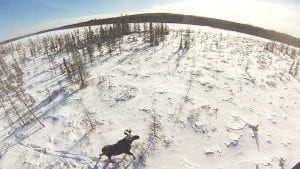Each year since 1960, Minnesota Department of Natural Resource researchers have conducted an aerial moose count and estimated the number of moose in the state. Since 2006 the number has dropped from almost 9,000 moose to an estimated 3,450 in 2015. Why the moose are dying (and if there is anyway to save them) is a mystery that wildlife scientists are in a hurry to figure out before moose are gone from our northland landscape.

A Minnesota Department of Natural Resources (DNR) aerial survey released on Tuesday, February 17 shows that Minnesota’s moose population continues to decline, with no let up in sight.
This year spotters working from a helicopter counted 392 moose. The helicopter crews conducted their count from January 13 to January 29, flying over 52 randomly selected plots of 13 square miles each. Moose were seen on 34 (65 percent) of the 52 plots, which wasn’t very different from the 2014 count where 419 moose were spotted on 41 plots. Based on those counts it was estimated that there were 4,350 moose in northeastern Minnesota in 2014 and 3,450 in 2015, a drop of 20 percent.
In 2006 the DNR estimated that there were 8,840 moose in the state. The 2015 estimate is a 60 percent drop from the 2006 count, and DNR researchers and wildlife scientists are working diligently and urgently to figure out what is causing the crash in population.
The survey area is approximately 5,985 miles. Every five years the DNR reviews the plots and classifies them as low, medium or high moose density areas, and from this information 52 plots are randomly selected for the aerial count each year.
Glenn DelGuidice, DNR Forest Wildlife Populations and Research Group leader, released the 2015 report. In the document, DelGuidice said, “After adjusting for sampling and sight ability we estimated the population in northeastern Minnesota at 3,450.”
Two local areas where a lot of moose were spotted were in the vicinity of the Cavity and Ham Lake fires. New growth allows easy access for moose to browse. With fewer fires recently and a drop off in logging in the county, moose have had fewer good places to forage for food, which also might be contributing to their decline.
The DNR is in its third year of conducting adult and calf mortality studies, radio collaring moose, tracking and examining them within a 24-hour period of their deaths to determine what has killed them.
Last year 11 percent of collared moose died, down from 21 percent the year before. However the calf mortality study has shown that more than 70 percent of moose die within their first year, much higher than expected.
DNR crews will radio-collar 36 more adult moose this winter and 50 newborn calves in the spring in an effort to continue with the mortality study and will try to determine if anything can be done to halt the decline.
Some of the culprits identified that are killing moose include brain worm, winter ticks, bears and wolves. Researchers also believe warmer summers caused by climate change have been stressing moose and causing them to die.
The DNR cancelled the bulls only moose hunt in 2013, and until the decline in population steadies or reverses, there is no sign the hunt will be back anytime soon.


Loading Comments